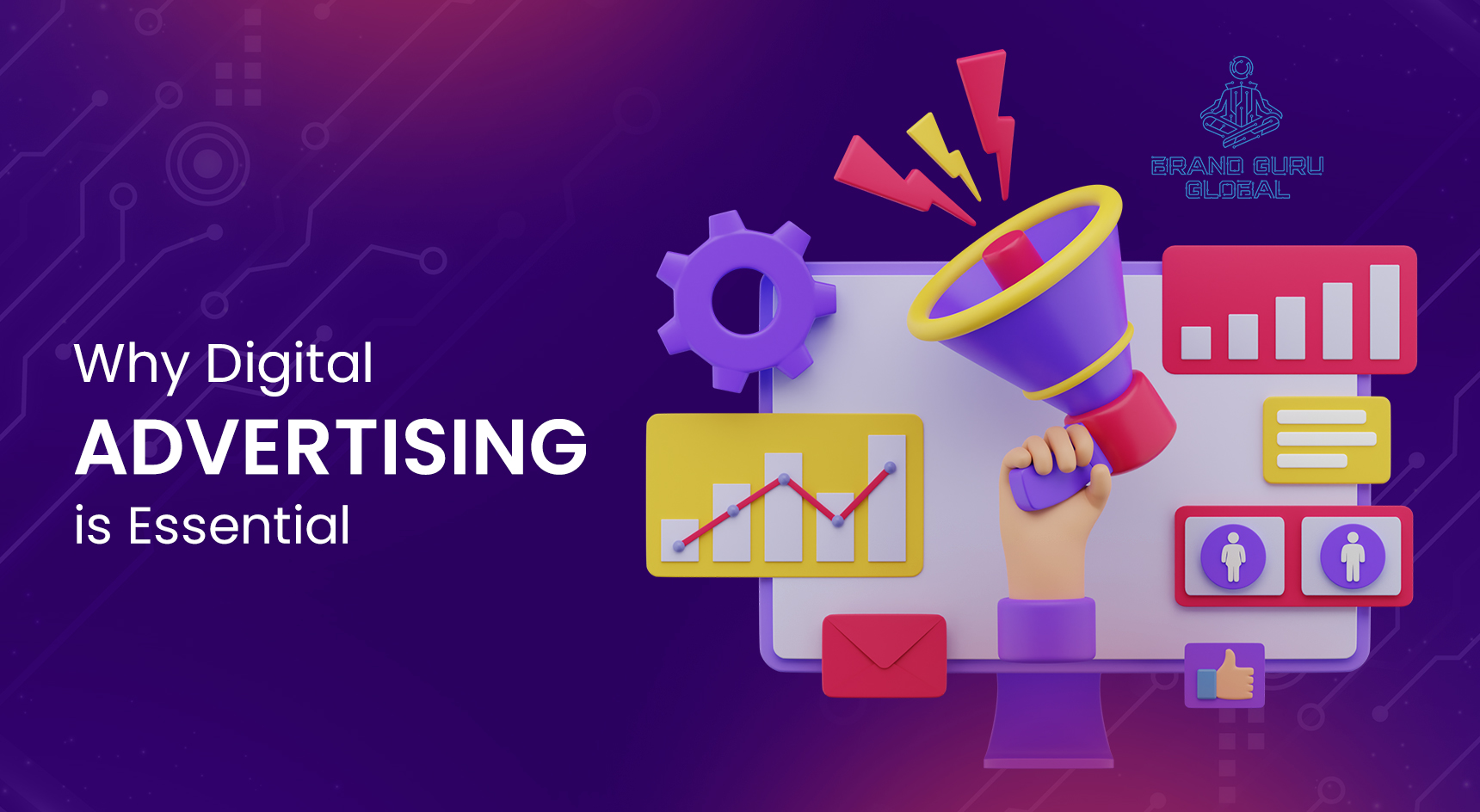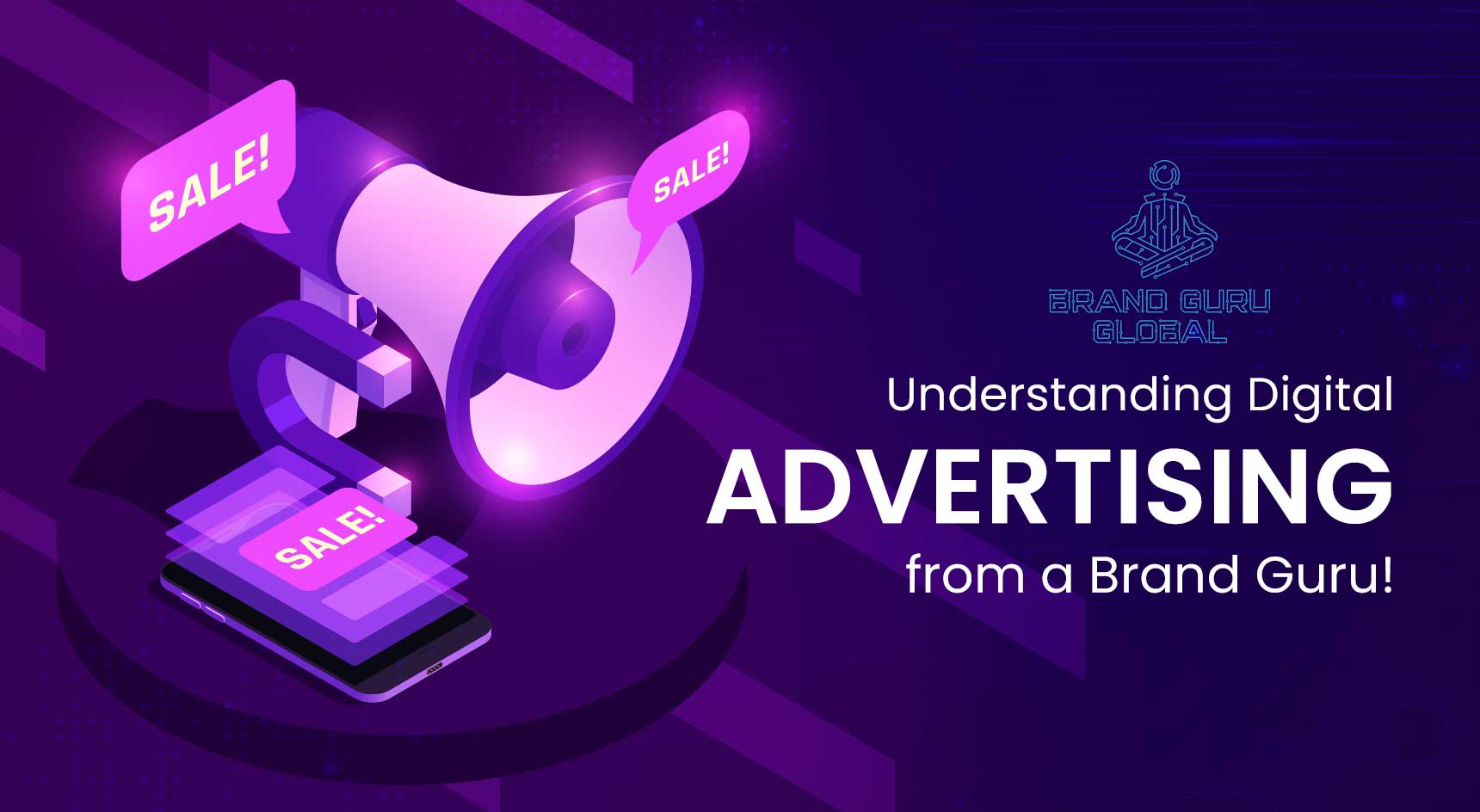In today’s digital age, where nearly everyone is connected to the internet, digital advertising has emerged as a cornerstone of successful marketing strategies. Whether you run a personal blog or a thriving e-commerce website, harnessing the power of digital advertising can significantly impact your online presence, boost engagement, and drive revenue. In this comprehensive blog, Brand Guru will explore the world of digital advertising, its various forms, strategies, and tips to help you make the most out of it for your website.
Understanding Digital Advertising:
a. What is Digital Advertising:
Digital Advertising is a multipronged approach that covers a grand strategy of consumer outreach via vast range of online tactics to promote products, services, or brands. Digital marketing covers everything from social media marketing and content marketing to email marketing, pay-per-click advertising, and search engine optimization (SEO). Each of the above components has a unique purpose as a tactic, but they all converge under the grand strategy of reaching consumers online.
b. The Evolution of Digital Advertising AKA the history of the Internet:
- The birth of the Internet (Early1990s): Digital marketing began with the advent of the internet. During this early period of the internet’s history, businesses started to create websites and use email marketing as a means to reach a wider audience. At this stage users pretty much knew exactly what domain they wanted to visit and why due to information and influence from real world advertising or word of mouth.
- Search Engine Optimization (SEO): In the early 2000s, SEO emerged as a crucial aspect of digital marketing. Marketers realized the importance of optimizing websites for search engines like Google to improve visibility in search results. Essentially the internet was the Wild West, the user decided what they wanted to see and if the websites were optimized for those keywords they would successfully get that traffic.
- Social Media Revolution (Mid-2000s): The rise of social media platforms like Facebook, Twitter, and LinkedIn revolutionized digital marketing. Brands began to engage with customers on these platforms, allowing for more personalized and interactive marketing campaigns. Social media became the fastest growing community in the world and brands couldn’t miss out on this opportunity to sell their products and services.
- Content Marketing (Late 2000s): Content marketing gained prominence as businesses recognized the value of providing valuable and relevant content to their audience. Blogging, infographics, videos, and podcasts became popular mediums for content delivery. This ushered in the beginnings of the attention economy which would later give form to the internet as we know it now.
- Mobile Optimization (2010s): With the proliferation of smartphones, mobile optimization became a priority. Responsive web design and mobile apps allowed brands to engage with users on their mobile devices effectively. Seamless functionality and ease of use, made the smart phone the new computer always a touch away, and mobile applications become user optimized and almost dummy proof versions of their web counterparts.
- Data Analytics and Personalization: Advanced data analytics tools provided marketers with unique insights into consumer behavior. Personalization became a key strategy, enabling businesses to deliver tailored content and offers to individual consumers. This was a marketing departments dream come true, actual live and documented insights into consumer preferences were only possible through surveys and intensive “KNOW YOUR CLIENT” calls from sales reps.
- Video Marketing: Video content, including YouTube and live streaming, gained tremendous traction in the late 2010s. Video marketing became an essential part of digital marketing strategies. Live streaming took the place of TV , where as consumers used to watch live shows on the news and sports , now consumers would be aligned with their favorite live streamers who could be utilized to promote brand products and services.
- Voice Search and AI (Late 2010s – Early 2020s): The rise of voice-activated devices like Amazon’s Alexa and Google Home prompted businesses to optimize for voice search. Artificial intelligence (AI) and machine learning further revolutionized digital marketing by automating tasks, analyzing data, and enhancing personalization.
- E-commerce and Social Commerce (2020s): The COVID-19 pandemic accelerated the shift towards online shopping. E-commerce and social commerce platforms like Instagram Shopping and Facebook Marketplace saw significant growth, changing the way businesses sell products online. The inaccessibility to brick and mortar stores due to the lockdown pushed the demographic who was most resistant to change from traditional off the shelf shopping into full time online consumers.
The Balance Small Business; Ecommerce Marketing Strategy - Privacy Concerns and Regulations: In response to growing concerns about data privacy, regulations like GDPR and CCPA were enacted, affecting how businesses collect and use customer data. Marketers had to adapt their practices to comply with these regulations.
Digital Marketing Institute; Understanding GDPR - The Metaverse and Beyond (You are here! ): As technology continues to advance, digital marketing is likely to evolve further. The concept of the metaverse, virtual and augmented reality, and new communication platforms may present exciting opportunities for marketers to connect with audiences in innovative ways such as virtual marketplaces. Businesses within the property and real estate sector are already utilizing augmented reality and virtual reality to provide virtual property tours.The evolution of digital marketing underscores the importance of staying current with trends and technologies. Successful digital marketers must be adaptable, data-driven, and focused on delivering value to their audience in an ever-changing digital landscape.
TechCrunch
c. Why Digital Advertising is Essential

Widespread Online Presence: Consumers spend a substantial portion of their time online, whether it’s on social media, search engines, or other websites. Businesses may meet their customers where they are most active by using digital advertising.
Cost-effective: When compared to traditional advertising strategies, digital advertising frequently gives a higher return on investment (ROI). You can set exact budgets, track spending, and optimize campaigns in real time, ensuring that you get the most bang for your buck with your advertising expenditures.
Reach: Digital advertising systems provide granular targeting choices. This means that you can target a certain audience based on demographics, interests, behavior, location, and other factors. This precision decreases ad spend waste and boosts the likelihood of reaching potential buyers.
Measurable Results: Digital advertising gives real-time performance measurements. Impression, click, conversion, and other key performance indicators (KPIs) can be tracked by marketers. This information allows for data-driven decision-making as well as the option to adjust and optimize campaigns on the go.
Flexibility and Customization: Ad formats in digital advertising are customizable. Businesses can personalize their messaging to suit their marketing aims and audience preferences via text advertisements, display banners, video commercials, or sponsored content.
Worldwide Reach: Digital advertising empowers firms to reach audiences all over the world without regard to geography. This is especially useful for businesses seeking to expand beyond their local markets.
Engagement and Interaction: Interactive digital commercials, including those on social media and interactive videos, successfully captivate consumers more so than static ads do. They promote direct interactions such as clicking, liking, sharing, and commenting in order to increase the brand’s engagement and foster consumer relationships.
Personalization: Personalized advertising experiences are made possible by advanced data analysis and AI-driven algorithms. This means that adverts can be personalized to specific user preferences, boosting conversion rates.
Competitive Advantage: In most businesses, competitors have begun to utilize the advantage of digital advertising. Businesses must have a strong online presence and efficiently use digital advertising methods to remain competitive.
Adaptability: Digital advertising platforms are constantly evolving, with new features and formats being introduced. This versatility enables firms to stay current with evolving trends and technologies, ensuring that their advertising remains effective.
Quick Results: Unlike certain traditional advertising strategies, which may take time to produce results, digital marketing often yields immediate results. This versatility is critical for organizations that must react quickly to market changes or offerings.
Brand Recognition: Digital advertising aids in increasing awareness and recognition of the brand. Consistent exposure through digital advertisements aids in the establishment of a brand presence in the minds of consumers which can be effectively understood as the brand identity.
In today’s digital age, when consumers rely extensively on the internet and mobile devices, digital advertising is not only necessary, but it is frequently the major means of communicating with and converting potential customers. Businesses that efficiently use digital advertising are better positioned to compete, grow, and win in today’s market.
Conclusion
Digital advertising is a valuable asset for website owners of all sizes, not just large organizations. You may use digital advertising to achieve your website’s goals by understanding its various forms, developing an effective plan, and staying up to date on the current developments. Whether you want to increase traffic, optimize sales, or simply increase the awareness of your brand, digital advertising can be the driving force behind your online success. It can be said that digital marketing is the ultimate equalizer in the battle for market share, where even smaller players have a chance to take on the giants by utilizing effective campaigns online and garnering hype for their brand.
We’ve covered everything from the fundamentals of digital advertising to advanced methods and future developments in our blog. You’ll be well on your way to harnessing the actual power of digital advertising for your website if you use the knowledge and insights provided here. Keep in mind that the digital scene is continuously changing, so staying informed and adapting to change is key to long-term success in the world of online advertising.







